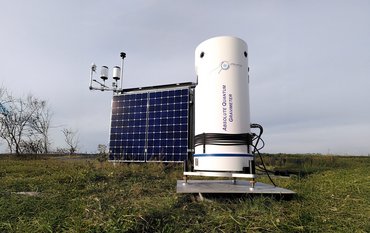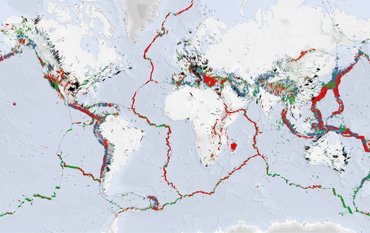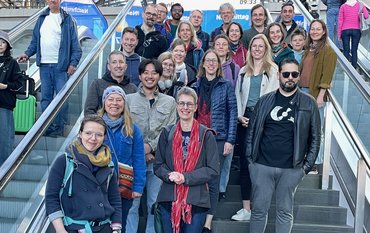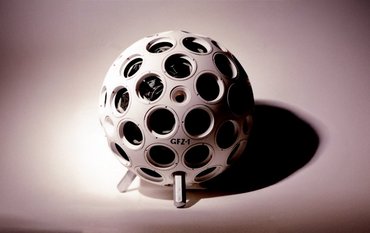Summary
In recent years, increasing earthquakes in the Campi Flegrei volcanic complex beneath the metropolitan area of Naples, Italy, with a population of 900,000, have been causing concern. Just recently, the strongest earthquake ever recorded in the region, with a magnitude of M 4.6, was registered. The earthquakes are accompanied by ground uplift, which has amounted to around 1.4 metres since 2005. Analysis of selected earthquakes over the last ten years has now provided new insights into volcanic structures. These findings were published in the journal Nature Communications Earth and Environment by a team led by Giacomo Rapagnani from the University of Pisa and Dr Simone Cesca from the GFZ Helmholtz Centre for Geosciences in Potsdam. They offer new approaches to risk assessment. Among other things, newly discovered long-period seismic signals indicate a fissure-like structure at a depth of around 3.5 kilometres. It connects the underlying magma and gas reservoir with fumaroles, i.e. volcanic steam vents, near the surface. The resonance frequency of the signals has not changed over the past few years, indicating that the overlying rock above the magmatic reservoir is currently still stable.
Background: Earthquakes and ground uplift in the Phlegraean Fields
The Campi Flegrei are a volcanic complex within a large caldera structure in the densely populated Bay of Naples in Italy. Since 2005, the ground there has been uplifting by approximately 1.4 metres, accompanied by earthquakes of increasing intensity, reaching a magnitude of M 4.6 on 30 June 2025. Seismicity and ground deformation are attributed to a degassing magma source and the subsequent interactions between magmatic and hydrothermal fluids. However, the details and geometry of the seismogenic structures are still a matter of debate in the scientific community.
New insights into the seismogenic structures
Now, an international team composed of researchers from the Istituto Nazionale di Geofisica e Vulcanologia (INGV), the University of Pisa (Italy), and the GFZ Helmholtz Centre for Geosciences (Germany) has investigated volcano-tectonic earthquakes at Campi Flegrei, occurring over the last 10 years. The seismological study, using advanced techniques for earthquake source characterization, reconstructs with unprecedented detail the geometry of the different seismogenic structures activated by the ground inflation.
The researchers reconstructed the geometry of the various seismogenic structures with unprecedented detail by analysing the seismic waveforms.
Among other things, they determined the location, depth and orientation of numerous weak zones and the mechanisms of the earthquake sources. The current results confirm earlier studies for the land area, but also provide new geometries and fault types for the submarine area east of Bacoli.
First evidence of long-period signals and their significance
The study also provides the first evidence resonance-like signals with very long periods (VLP) at Campi Flegrei, reporting more than a dozen of such VLPs, with durations of ~60-90 seconds and a dominant frequency of ~0.11 Hertz since 2018. The VLPs occur beneath the CO2 emissions at Solfatara, a dry maar in the urban area of Pozzuoli, west of Naples.
VLP signals and resonance processes are sometimes observed at other volcanoes, but they had never been recognised before at Campi Flegrei.
“We interpret the VLP signals as the resonance of one or more fluid-filled, crack-like structures, connecting the deformation source at depth with the fumarole locations at the surface. This oscillating, gas-filled structure offers a path for degassing, with a mutual interaction between fluid ascent, shallow fracturing and resonance processes,” says Giacomo Rapagnani, first author of the study and PhD student at the University of Pisa, funded by an INGV scholarship.
Based on the resonance frequency and the location of a cluster above it, researchers estimate the dimensions of the newly discovered structure to be approximately 1,000 metres long, 650 metres wide and around 0.35 metres high.
Relevance of the observations
What does this mean? “Interestingly, the VLP waveforms and spectra have been extremely similar in recent years. This suggests that the geometry and conditions of the resonating source have remained quite stable, and we are not seeing clear indications of substantial changes in the physical properties of the fluids which sustain the resonance,” says Simone Cesca, second author and scientist at the GFZ Section Physics of Earthquakes and Volcanoes. “The unchanging resonance frequency shows us that the crack structures beneath the Solfatara have probably not grown in recent years, despite constant ground uplift. In this respect, we have no indications of an imminent eruption in the Solfatara.”
“This observation underscores the relevance of the obtained results for tracking the dynamic evolution of the volcano, though further investigation is needed to better constrain the physical processes that govern the system”, says Gilberto Saccorotti, from INGV.
“This study highlights how the development and application of sophisticated techniques for the analysis of seismological data are essential to better understand complex geophysical processes, such as earthquakes and volcanic eruptions. Only by pushing the limits of our ability to analyse large volumes of heterogeneous data can we improve our understanding of these phenomena and more effectively mitigate their related risk,” says Francesco Grigoli from the University of Pisa.
Background: GFZ measuring stations at Campi Flegrei
In June 2024, the GFZ, in cooperation with the Osservatorio Vesuviano of the INGV, installed nine SeismiQ/QuakeSaver seismometers in the Campi Flegrei to strengthen the local network. Since then, these have been sending data to GEOFON in real time and contributed to the current study.
The GEOFON programme is part of the GFZ's MESI infrastructure. It consists of a global seismic network (GE network), a seismological data centre (GEOFON_DC) and a global earthquake monitoring system (GEOFON EQinfo). GEOFON provides real-time seismic data, access to its own and external data in its archive, and fast, worldwide earthquake information.
GEOFON has also developed the Earthquake Explorer for the fast, worldwide provision of earthquake information – both on current earthquake events and on earthquakes that occurred in the past (up to August 2007).
Original study:
Rapagnani, G., Cesca, S., Saccorotti, G., Petersen, G., Dahm, T., Bianco, F., Grigoli, F. , Coupled earthquakes and resonance processes during the uplift of Campi Flegrei caldera. Commun Earth Environ 6, 607 (2025). https://doi.org/10.1038/s43247-025-02604-7



![[Translate to English:] Map showing volcanic structures and the two large calderas that form a large circle around the city of Pozzuoli.](/fileadmin/_processed_/b/8/csm_campi-flegrei-Karte-Zeitleiste_eskp_9cb5648068.png)

![[Translate to English:] Complex graphic showing the composition and viscosity of the Earth's crust several billion years ago in a semicircular arc.](/fileadmin/_processed_/a/0/csm_active_subduction_27-17_f1f7f7_Schrift_Legende_en_836d3f0dac.png)


![[Translate to English:] Map](/fileadmin/_processed_/4/6/csm_Map_ELISE_a53d2d3dd7.png)

![[Translate to English:] Portraitfoto](/fileadmin/_processed_/3/d/csm_20250715-kachel_Paola-Vannucchi_-c-Jason-Morgan_f4c48783a6.jpeg)











![[Translate to English:] PAGER Products (graphic illustration)](/fileadmin/_processed_/7/1/csm_20250616_Fig3-all_8f563a96c8.jpeg)
![[Translate to English:] Mine and water](/fileadmin/_processed_/7/f/csm_Figure_PHS_greece_e245cdf614.png)










